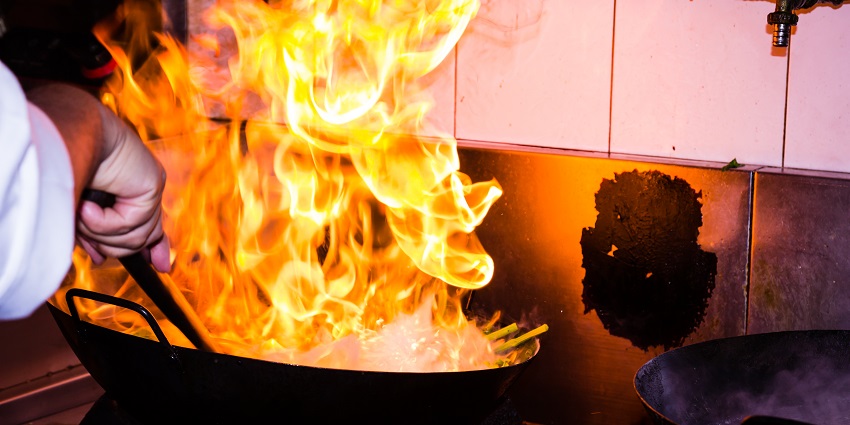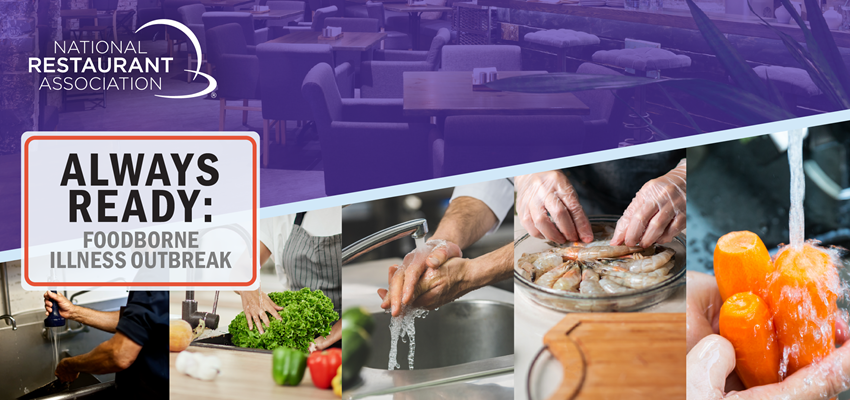Fighting fires in restaurant kitchens

If you encounter a small flare up contained in a pan, instruct staff to cover it with a pan lid, fire blanket, or other solid covering to cut off the fire’s access to oxygen.
Training staff on fire safety has multiple steps and is imperative: they need to know what to do to prevent fires from occurring (identifying risks), how to respond in case a fire breaks out, and how to safely recover from it. Always Ready: Fire, the Association’s newest edition in its series of emergency preparedness guides, provides recommendations on each of those stages.
Any restaurant’s first line of fire safety is to confer with local fire safety authorities to ensure the facility is up to code and learn best practices from their veteran pros. They’ll share information about what your team should do if a fire occurs in your restaurant.
Extinguishers: a class of their own
Both the built-in fire suppression system over the cookline and your handheld Class K fire extinguishers use wet vs. dry chemical fire suppression chemicals to extinguish fires fueled by today’s cooking oils. Those oils burn at higher temperatures than in the past and the wet chemical suppressant puts the fires out and stops them from reigniting.
Class ABC extinguishers use a dry chemical suppressant that effectively starves burning materials of oxygen. A Class A extinguisher can put out fires burning wood and paper. Class B extinguishers are for use on flammable liquids, including petroleum, gas, oil, paint, and propane. Class C are for fires from shorts in electrical wiring. If you purchase an ABC extinguisher, its multipurpose dry chemical smothers all three types of fires.
But you need Class K in your kitchen.
Inspect your extinguishers
To inspect your operations’ fire extinguishers in advance, the National Fire Protection Association says to ...
- Ensure the pressure gauge is in the operable range or position.
- Make sure the tank is full; this can be done by lifting the extinguisher or weighing it.
- For non-rechargeable extinguishers, operate the push-to-test pressure indicators.
- Make sure the extinguisher is visible or that there’s signage indicating where the extinguisher is located.
- Class Ks require signage that says they’re to be used after the automatic fire suppression system has activated.
- Make sure you can easily access the extinguisher and exit the area after use.
Not so great balls of fire
In your fire safety training, make it clear that throwing water on a grease fire is one of the most dangerous things your employees can do.
It may seem counterintuitive, but water and grease don’t mix, so when someone tosses water onto a grease-based fire in a pan or fryer, it will create an explosive fire ball, splattering the hot grease and spreading the fire quickly.
Drive this home: Fire needs oxygen to burn.
If you encounter a small flare up contained in a pan, instruct staff to cover it with a pan lid, fire blanket, or some other solid covering that cuts off the fire’s access to oxygen. Don’t swat the flareup with a dish towel or apron either; that will only add oxygen to the fire rather than cutting off its air supply. And don’t try to move the flaming pan to a counter or sink.
If the fire is more intense (on or in the range top, oven, broiler, fryer, etc.) the automatic fire suppression system will go off (it also shuts off the gas and or electric power to the equipment cookline). This system features automatic operation (via sensors) backed up by a separate manual trigger in case the automatic operation fails. Train all your employees about the system and the location of the manual pull.
Train them, too, on how to use a handheld fire extinguisher:
- Sound the fire alarm and call 911.
- Identify an evacuation path before approaching the fire with the extinguisher. Don’t let the fire, heat, or smoke come between you and your exit.
Also, use the P.A.S.S. technique:
- Pull the pin on the handle to break the seal.
- Aim low at the base of the fire.
- Squeeze the handle to release the extinguishing agent.
- Sweep the extinguisher from side to side.
Last, but not least...
- Evacuate immediately if the extinguisher is empty and the fire is extinguished.
- Evacuate immediately if the fire continues to grow.
Equipment exchange?
The automatic fire suppression system over the cookline is carefully engineered, and it’s designed to disperse fire-suppressing chemical agent onto the equipment below in a specific direction and from a particular distance.
If you replace a piece of equipment, change one type of equipment for another type, or rearrange your equipment under the hood, you need to have the suppression system reengineered to match the new formation, otherwise it may not suppress a cookline fire the way it was designed to do.
Always Ready: Fire is free to download. It covers fire preparedness steps, including what to do before a fire breaks out, safety during a fire, and fire recovery efforts.
